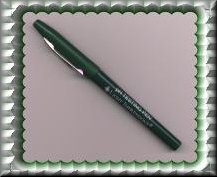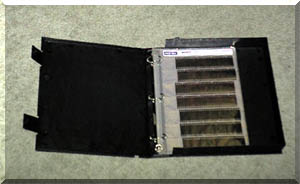
|
After you've taken pictures...
Until oil paintings, photos, slides, and negatives do not last very long. It is very important to preserve them with proper means. Today you can have many high tech solutions. For example, you can scan your pictures into Kodak Photo CD or other digital formats. But if you cannot afford those expensive archival methods, I would suggest some conventional storage tips to you. First, you have to store photos, slides, and negatives in a dark and cool place, because they will fade very fast under bright light and high temperature. Second, you have to use all acid-free materials.
 Photo albums, matt boards, frames, tapes, photo papers, slide holders, and negative savers that are made of acid contents must be avoided. Acid-free products should be labelled as "acid-free" or "No PVC emission." But if there is no indication of the acid level on the product label, you can use a pH testing pen as shown on the left to examine the product. A pH testing can be purchased from a professional archival company. If the tested item contains strong acid, the ink color marked by the pen will turn yellow. If the acid level is medium, the color will be green. Blue is the sign of totally acid-free.
Photo albums, matt boards, frames, tapes, photo papers, slide holders, and negative savers that are made of acid contents must be avoided. Acid-free products should be labelled as "acid-free" or "No PVC emission." But if there is no indication of the acid level on the product label, you can use a pH testing pen as shown on the left to examine the product. A pH testing can be purchased from a professional archival company. If the tested item contains strong acid, the ink color marked by the pen will turn yellow. If the acid level is medium, the color will be green. Blue is the sign of totally acid-free.
You can choose most of the above photo products except photo papers and slide holders, unless you process your own pictures. It is advisable that you test the photo paper and the slide holder when you receive them from a photo lab. If you see yellow or green, send your films to another photo lab next time.
You must test not only the archival materials, but also your hands. Before you touch any negative, picture, or slide, use a pH pen to draw a line across your five fingers on both hands and check the result. You may handle acid-heavy materials before.
 The mounting tape and mounting corner on the right picture are some examples of acid-free products. I pefer to use the latter because a mounting tape has direct contact to your photo but a mounting corner does not. Even though the glue on the tape is acid-free, eventually it may hurt your photo. On the other hand, a mounting corner is a clear holder, which tapes itself on the album paper or the matt board. It allows you to slide the corners of your photo to the holder and no glue touches your picture at all.
The mounting tape and mounting corner on the right picture are some examples of acid-free products. I pefer to use the latter because a mounting tape has direct contact to your photo but a mounting corner does not. Even though the glue on the tape is acid-free, eventually it may hurt your photo. On the other hand, a mounting corner is a clear holder, which tapes itself on the album paper or the matt board. It allows you to slide the corners of your photo to the holder and no glue touches your picture at all.
 Today most negative savers are acid-free. You may think that it is convenient to store your negative savers in a three-hole binder. However, you should not use just any binder. Instead, use a box-like binder as shown on the left. It is not only acid-free, but also is weather-proof and complelely isolate your negatives from light. Negatives tend to fade much slower in complete darkness.
Today most negative savers are acid-free. You may think that it is convenient to store your negative savers in a three-hole binder. However, you should not use just any binder. Instead, use a box-like binder as shown on the left. It is not only acid-free, but also is weather-proof and complelely isolate your negatives from light. Negatives tend to fade much slower in complete darkness.
|
 Photo albums, matt boards, frames, tapes, photo papers, slide holders, and negative savers that are made of acid contents must be avoided. Acid-free products should be labelled as "acid-free" or "No PVC emission." But if there is no indication of the acid level on the product label, you can use a pH testing pen as shown on the left to examine the product. A pH testing can be purchased from a professional archival company. If the tested item contains strong acid, the ink color marked by the pen will turn yellow. If the acid level is medium, the color will be green. Blue is the sign of totally acid-free.
Photo albums, matt boards, frames, tapes, photo papers, slide holders, and negative savers that are made of acid contents must be avoided. Acid-free products should be labelled as "acid-free" or "No PVC emission." But if there is no indication of the acid level on the product label, you can use a pH testing pen as shown on the left to examine the product. A pH testing can be purchased from a professional archival company. If the tested item contains strong acid, the ink color marked by the pen will turn yellow. If the acid level is medium, the color will be green. Blue is the sign of totally acid-free.
 The mounting tape and mounting corner on the right picture are some examples of acid-free products. I pefer to use the latter because a mounting tape has direct contact to your photo but a mounting corner does not. Even though the glue on the tape is acid-free, eventually it may hurt your photo. On the other hand, a mounting corner is a clear holder, which tapes itself on the album paper or the matt board. It allows you to slide the corners of your photo to the holder and no glue touches your picture at all.
The mounting tape and mounting corner on the right picture are some examples of acid-free products. I pefer to use the latter because a mounting tape has direct contact to your photo but a mounting corner does not. Even though the glue on the tape is acid-free, eventually it may hurt your photo. On the other hand, a mounting corner is a clear holder, which tapes itself on the album paper or the matt board. It allows you to slide the corners of your photo to the holder and no glue touches your picture at all.
 Today most negative savers are acid-free. You may think that it is convenient to store your negative savers in a three-hole binder. However, you should not use just any binder. Instead, use a box-like binder as shown on the left. It is not only acid-free, but also is weather-proof and complelely isolate your negatives from light. Negatives tend to fade much slower in complete darkness.
Today most negative savers are acid-free. You may think that it is convenient to store your negative savers in a three-hole binder. However, you should not use just any binder. Instead, use a box-like binder as shown on the left. It is not only acid-free, but also is weather-proof and complelely isolate your negatives from light. Negatives tend to fade much slower in complete darkness.